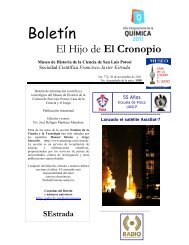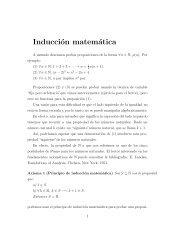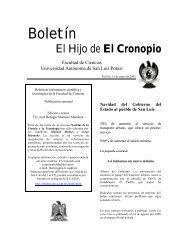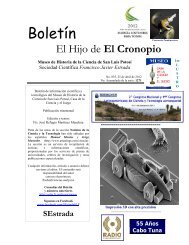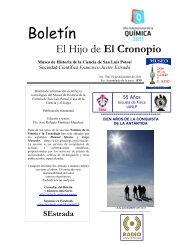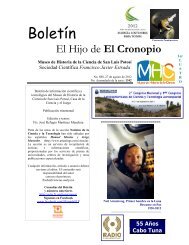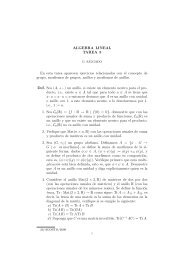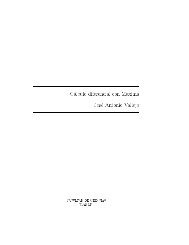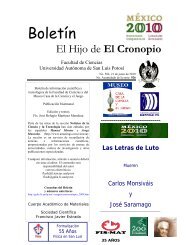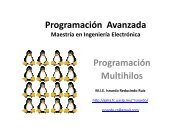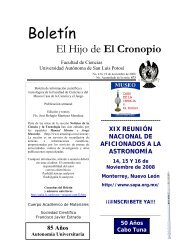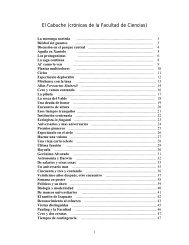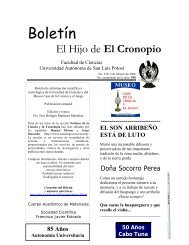Cuando DCEN=0, el Timer 2 automáticamente realiza un
Cuando DCEN=0, el Timer 2 automáticamente realiza un
Cuando DCEN=0, el Timer 2 automáticamente realiza un
Create successful ePaper yourself
Turn your PDF publications into a flip-book with our unique Google optimized e-Paper software.
Microcontroladores<br />
Microcontroladores<br />
El El <strong>Timer</strong>2 <strong>Timer</strong>2 d<strong>el</strong> d<strong>el</strong> 89C52<br />
89C52<br />
El <strong>Timer</strong>2 d<strong>el</strong> 89C52<br />
El <strong>Timer</strong> 2<br />
Carlos E. Canto Quintal M.C.<br />
El <strong>Timer</strong> 2 es <strong>un</strong> <strong>Timer</strong>/Contador de 16 bits que puede ser operado ya sea<br />
como timer o como contador de eventos.<br />
El tipo de operación operaci n es s<strong>el</strong>eccionado por <strong>el</strong> bit C/T2 <strong>el</strong> SFR T2CON .<br />
El <strong>Timer</strong> 2 tiene 3 modos de operación:<br />
operaci n:<br />
• Modo de Captura<br />
• Auto-recarga Auto recarga (conteo ascendente-descendente)<br />
ascendente descendente)<br />
• Generador de Baudaje.<br />
Baudaje<br />
Los modos se s<strong>el</strong>eccionan con los bits d<strong>el</strong> T2CON.<br />
El <strong>Timer</strong> 2 consiste de dos registros de 8 bits, TH2 y TL2.<br />
La operación operaci n d<strong>el</strong> timer 2, tanto como timer como contador de eventos<br />
externos, es similar a la de los <strong>Timer</strong>s 0 y 1.<br />
El <strong>Timer</strong> 2
Microcontroladores<br />
SIMBOLO<br />
TF2<br />
EXF2<br />
RCLK<br />
TCLK<br />
EXEN2<br />
TR2<br />
C/T2<br />
CP/RL2<br />
(MSB)<br />
POSICIÓN<br />
T2CON.7<br />
T2CON.6<br />
T2CON.5<br />
T2CON.4<br />
T2CON.3<br />
T2CON.2<br />
T2CON.1<br />
T2CON.0<br />
Carlos Canto Quintal<br />
Microcontroladores<br />
T20E<br />
DCEN<br />
T2CON: REGISTRO DE CONTROL DELTIMER/CONTADOR2<br />
TIMER 2<br />
(LSB)<br />
CP/RL2<br />
TF2 EXF2 RCLK TCLK EXEN2 TR2 C/T2 CP/RL2<br />
NOMBRE Y SIGNIFICADO<br />
Bandera de sobre flujo d<strong>el</strong> <strong>Timer</strong>2 se hace 1 con <strong>el</strong> rebase d<strong>el</strong> <strong>Timer</strong> y debe hacerse 0 por software.TF2 no se hace 1 cuando RCLK=1<br />
o cuando RCLK=1<br />
Bandera externa d<strong>el</strong> <strong>Timer</strong>2, se hace 1 cuando ya sea <strong>un</strong>a captura o <strong>un</strong>a recarga sea producida desde <strong>el</strong> exterior, al ocurrir <strong>un</strong>a<br />
transición negativa en T2EX y además que EXEN2=1. Siempre la interrupción d<strong>el</strong> timer 2 esté habilitada, EXF2=1 hará que la CPU<br />
vectorice a la rutina de servicio d<strong>el</strong> timer 2. EXF2 debe deshabilitarse por software. EXF2 no produce <strong>un</strong>a interrupción en modo<br />
contador Up//Down (DCEN=!)<br />
Bandera d<strong>el</strong> r<strong>el</strong>oj de recepción. <strong>Cuando</strong> se hace 1, hace que <strong>el</strong> puerto serie use los pulsos d<strong>el</strong> sobre flujo d<strong>el</strong> timer 2 para <strong>el</strong> r<strong>el</strong>oj de su<br />
receptor en los Modos 1 , 3 y <strong>el</strong> timer 1 proporcionará <strong>el</strong> baudaje d<strong>el</strong> transmisor. RCLK=0 hará que <strong>el</strong> sobre flujo d<strong>el</strong> <strong>Timer</strong> 1 sea usado<br />
para <strong>el</strong> r<strong>el</strong>oj d<strong>el</strong> receptor<br />
Bandera de r<strong>el</strong>oj d<strong>el</strong> transmisor. <strong>Cuando</strong> está en 1, hace que <strong>el</strong> puerto serial use los pulsos d<strong>el</strong> sobre flujo d<strong>el</strong> timer 2 para <strong>el</strong> r<strong>el</strong>oj de su<br />
transmisor en los Modos 1 , 3 y <strong>el</strong> timer 1 proporcionará <strong>el</strong> baudaje d<strong>el</strong> receptor. TCLK=0 hará que <strong>el</strong> sobre flujo d<strong>el</strong> <strong>Timer</strong> 1 sea usado<br />
para <strong>el</strong> r<strong>el</strong>oj d<strong>el</strong> transmisor.<br />
Bandera de habilitación externa, <strong>Cuando</strong> está habilitada permite que ocurra <strong>un</strong>a captura o <strong>un</strong>a recarga como resultado de <strong>un</strong>a<br />
transición negativa en T2EX si <strong>el</strong> <strong>Timer</strong> 2 no está siendo usado para temporizar <strong>el</strong> puerto serial. EXEN2=0 hace que <strong>el</strong> <strong>Timer</strong>2 ignore<br />
los eventos en T2EX<br />
Control de Arranque /Paro d<strong>el</strong> <strong>Timer</strong>2. Un 1 lógico arranca <strong>el</strong> <strong>Timer</strong>2<br />
S<strong>el</strong>ección de <strong>Timer</strong> o contador (<strong>Timer</strong>2)<br />
0=<strong>Timer</strong> interno (OSC/12)<br />
1=Contador de eventos externos (disparado en la transición de bajada)<br />
Bandera de Captura/Recarga. <strong>Cuando</strong> está en 1, ocurrirá <strong>un</strong>a captura con <strong>un</strong>a transición negativa en T2EX si EXEN2=1. <strong>Cuando</strong> está<br />
en cero, ocurrirá <strong>un</strong>a auto recarga ya sea cuando <strong>el</strong> <strong>Timer</strong> 2 rebase o <strong>un</strong>a transición negativa en T2EX y que EXEN=1. <strong>Cuando</strong> ya sea<br />
que RCLK=1 o TCLK=1, este bit es ignorado y <strong>el</strong> timer es forzado a <strong>un</strong>a auto recarga en <strong>el</strong> rebase d<strong>el</strong> <strong>Timer</strong> 2.<br />
TIMER 2<br />
(MSB)<br />
T2MOD: REGISTRO DE CONTROL DE MODO DEL TIMER/CONTADOR2<br />
(LSB)<br />
-- -- -- -- -- -- -- -- -- -- -- -- T20E DCEN<br />
DIRECCIÓN DIRECCI N DEL T2MOD=0C9H NO ES DIRECCIONABLE A BIT<br />
VALOR DE RESET=XXXXX00B<br />
SIMBOLO<br />
--<br />
--<br />
--<br />
--<br />
--<br />
--<br />
POSICIÓN<br />
T2MOD.7<br />
. T2MOD.6<br />
T2MOD.5<br />
T2MOD.4<br />
T2CON.3<br />
T2CON.2<br />
T2MOD.1<br />
T2MOD.0<br />
NOMBRE Y SIGNIFICADO<br />
NO IMPLEMENTADO , RESERVADO PARA EL FUTURO<br />
NO IMPLEMENTADO , RESERVADO PARA EL FUTURO<br />
TIMER2 OUTPUT ENABLE BIT (BIT HABILITADOR DE LA SALIDA DEL TIMER2)<br />
CUANDO SE PONE A “1” , PERMITE QUE EL TIMER2 SE CONFIGURE COMO CONTADOR<br />
CRECIENTE-DECRECIENTE (UP-DOWN)
Microcontroladores<br />
Microcontroladores<br />
Las Las Interrupciones<br />
El manejo de las Interrupciones en <strong>el</strong> 80C52<br />
Registro habilitador de las Interrupciones (IE:<br />
Interrupts Enable Register)) Register Register)) ))<br />
EA -- -- ET2 ES ET1 EX1 ET0 EX0<br />
SIMBOLO<br />
EA<br />
--<br />
ET2<br />
ES<br />
ET1<br />
EX1<br />
ET0<br />
EX0<br />
POSICIÓN<br />
IE.7<br />
IE.6<br />
IE.5<br />
IE.4<br />
IE.3<br />
IE.2<br />
IE.1<br />
IE.1<br />
deshabilita todas las interrupciones<br />
Reservada<br />
FUNCIÓN<br />
Bit habilitador de interrupción d<strong>el</strong> timer2<br />
Habilitador de interrupción d<strong>el</strong> puerto serie<br />
Habilitador de interrupción d<strong>el</strong> timer 1<br />
Habilitador de la interrupción externa 1<br />
Habilitador de interrupción d<strong>el</strong> timer 0<br />
Habilitador de la interrupción externa 0<br />
Fuentes de Interrupción Interrupci<br />
Interrupción n en <strong>el</strong> 80C52<br />
ET2<br />
Carlos E. Canto Quintal<br />
Las Las Interrupciones
Microcontroladores<br />
RCLK+TCLK<br />
0<br />
0<br />
1<br />
X<br />
Carlos Canto Quintal<br />
Microcontroladores<br />
MODOS DE OPERACIÓN OPERACI N DEL TIMER2<br />
CP/RL2<br />
0<br />
1<br />
X<br />
X<br />
TR2<br />
1<br />
1<br />
1<br />
0<br />
Captura de 16 bits<br />
Apagado<br />
MODO<br />
TIMER 2<br />
Auto-Recarga de 16 bits<br />
Generador de baudaje<br />
TIMER 2<br />
Modo Auto-recarga Auto recarga (contador Ascendente<br />
o Descendente)<br />
<strong>Cuando</strong> se configura en su modo de Auto-Recarga Auto Recarga de 16 bits, <strong>el</strong> timer 2<br />
puede ser programado para contar en forma ascendente o<br />
descendente.<br />
Esta habilidad es invocada con <strong>el</strong> bit DCEN (Down ( Down Co<strong>un</strong>ter Enable ),<br />
localizado en <strong>el</strong> SFR T2MOD<br />
Al resetear <strong>el</strong> CPU, <strong>el</strong> DCEN está est en cero, lo que hace que <strong>el</strong> <strong>Timer</strong> 2 por<br />
default cuente hacia arriba (Up).<br />
<strong>Cuando</strong> <strong>el</strong> DCEN se pone a <strong>un</strong>o, <strong>el</strong> <strong>Timer</strong> 2 puede contar hacia arriba arriba<br />
o<br />
hacia abajo, dependiendo d<strong>el</strong> valor de T2EX
Microcontroladores<br />
T2 T2<br />
T2EX<br />
osc<br />
Detector de<br />
transición<br />
Carlos Canto Quintal<br />
TIMER 2 EN MODO AUTO-RECARGA (cuando <strong>DCEN=0</strong>)<br />
Con la habilidad de conteo Up/Down desactivada<br />
_<br />
: : 12 12<br />
C/T2=1<br />
EXEN2<br />
Microcontroladores<br />
control<br />
C/T2=0<br />
TR2 TR2<br />
Recarga<br />
control<br />
TL2 TL2 TH2 TH2<br />
(8bits)<br />
(8bits)<br />
RCAP2L RCAP2L RCAP2H RCAP2H<br />
• <strong>Cuando</strong> <strong>DCEN=0</strong>, <strong>DCEN=0</strong> <strong>el</strong> <strong>Timer</strong> 2 autom<br />
TF2 TF2<br />
EXF2 EXF2<br />
TIMER 2<br />
Interrupción<br />
d<strong>el</strong> <strong>Timer</strong>2<br />
TIMER 2<br />
TIMER 2 EN MODO AUTO-RECARGA (cuando <strong>DCEN=0</strong>)<br />
Con la habilidad de conteo Up/Down desactivada<br />
, <strong>el</strong> <strong>Timer</strong> 2 <strong>automáticamente</strong> ticamente <strong>realiza</strong> <strong>un</strong><br />
conteo ascendente.<br />
• En este modo se pueden s<strong>el</strong>eccionar dos opciones con <strong>el</strong> bit<br />
EXEN2 d<strong>el</strong> T2CON.<br />
Si EXEN2 =0, <strong>el</strong> timer 2 cuenta hasta 0FFFFH y se activa <strong>el</strong> bit<br />
TF2 con <strong>el</strong> overflow. overflow<br />
El overflow también tambi n hace que los registros d<strong>el</strong> timer sean<br />
recargados con <strong>el</strong> valor de 16 bits en RCAP2H RCAP2L.<br />
• Los valores d<strong>el</strong> timer en modo captura, RCAP2H y RCAP2L son<br />
preestablecidos por programa.<br />
• si EXEN2=1, <strong>un</strong> arecarga de 16 bits puede ser producida ya sea<br />
por <strong>un</strong> overflow o por <strong>un</strong>a transición transici n de 0 a 1 en la entrada<br />
externa T2EX. Esta transición transici n también tambi n activa <strong>el</strong> bit EXF2. Tanto<br />
TF2 como EXF2 pueden generar <strong>un</strong>a interrupción interrupci n , si está est<br />
habilitada
Microcontroladores<br />
Generación Generaci<br />
Generación n de Interrupciones en <strong>el</strong> <strong>Timer</strong>2<br />
• La interrupción interrupci n d<strong>el</strong> <strong>Timer</strong> 2 es generada por <strong>un</strong> OR<br />
lógico gico entre los bits TF2 y EXF2 d<strong>el</strong> registro T2CON.<br />
• Ning<strong>un</strong>a de estas dos banderas son limpiadas por<br />
hardware cuando la rutina de servicio es invocada. De<br />
hecho, la Rutina de Servicio debe determinar cual de<br />
las dos banderas, TF2 o EXF2, fue la que generó gener la<br />
interrupción, interrupci n, y ese bit será ser limpiado en <strong>el</strong> programa.<br />
Carlos Canto Quintal<br />
Microcontroladores<br />
T2 T2<br />
T2EX<br />
osc<br />
_<br />
: : 12 12<br />
C/T2=1<br />
C/T2=0<br />
Valor de recarga en<br />
conteo ascendente<br />
TR2<br />
TF2 TF2<br />
EXF2 EXF2<br />
control<br />
Interrupción<br />
d<strong>el</strong> <strong>Timer</strong>2<br />
TIMER 2 EN MODO AUTO-RECARGA (cuando DCEN=1)<br />
Con la habilidad de conteo Up/Down activada<br />
Valor de recarga en<br />
conteo descendente<br />
Dirección de conteo<br />
1= Up<br />
0=Down<br />
0FFh 0FFh<br />
TL2 TL2 TH2 TH2<br />
(8bits)<br />
(8bits)<br />
RCAP2L RCAP2L RCAP2H RCAP2H<br />
conmuta<br />
EXF2 EXF2<br />
TF2 TF2<br />
TIMER 2<br />
TIMER 2<br />
Interrupción<br />
d<strong>el</strong> <strong>Timer</strong>2
Microcontroladores<br />
TIMER 2 EN MODO AUTO-RECARGA (cuando DCEN=1)<br />
Con la habilidad de conteo Up/Down activada<br />
TIMER 2<br />
• <strong>Cuando</strong> DCEN=1 , <strong>el</strong> <strong>Timer</strong>2 <strong>realiza</strong> <strong>un</strong> conteo descendente.<br />
• En este modo la terminal T2EX controla la dirección direcci n d<strong>el</strong> conteo .<br />
• Un “1” lógico gico en T2EX hace que <strong>el</strong> <strong>Timer</strong>2 cuente hacia arriba.<br />
– El <strong>Timer</strong> hará har overflow en 0FFFFH y activa la bandera TF2. Este<br />
overflow también tambi n hace que <strong>el</strong> valor de 16 bits de RCAP2H y RCAP2L<br />
sea recargado en los registros d<strong>el</strong> timer, TH2 y TL2 respectivamente.<br />
respectivamente.<br />
• Un “0” lógico gico en T2EX, hace al <strong>Timer</strong>2 contar hacia abajo.<br />
– El timer hace <strong>un</strong> <strong>un</strong>derflow cuando TH2 y TL2 igualan <strong>el</strong> valor<br />
almacenado en RCAP2H y RCAP2L. El <strong>un</strong>derflow activa <strong>el</strong> bit TF2 y<br />
hace los registros d<strong>el</strong> timer sean recargados con 0FFFFh. 0FFFFh<br />
• El bit EXF2 conmuta siempre que <strong>el</strong> <strong>Timer</strong>2 haga ya sea overflow<br />
o <strong>un</strong>derflow y puede ser usado como <strong>el</strong> 17avo bit de resolución.<br />
resoluci .<br />
• En este modo de operación, operaci n, EXF2 no invoca <strong>un</strong>a interrupción.<br />
interrupci n.<br />
Carlos Canto Quintal<br />
Microcontroladores<br />
Modo Captura<br />
En <strong>el</strong> modo captura, hay dos opciones escogidas con <strong>el</strong> bit EXEN2 d<strong>el</strong><br />
T2CON.<br />
Si EXEN2=0, <strong>el</strong> <strong>Timer</strong> 2 es <strong>un</strong> timer o contador de 16 bits y cuando cuando<br />
hay<br />
desborde de su conteo, habilita la bandera TF2 d<strong>el</strong> T2CON, que puede ser<br />
usada para generar <strong>un</strong>a interrupción.<br />
interrupci n.<br />
Si EXEN2=1, <strong>el</strong> <strong>Timer</strong> 2 <strong>realiza</strong> la misma operación, operaci n, pero <strong>un</strong>a transición transici n de<br />
1 a 0 en la entrada externa T2EX también tambi n hace que <strong>el</strong> valor actual de TH2<br />
y TL2 sean capturados en RCAP2H y RCAP2L, respectivamente.<br />
Además Adem s la transición transici n en T2EX hace que <strong>el</strong> bit EXF2 d<strong>el</strong> T2CON se haga “1”. .<br />
El bit EXF2, al igual que TF2, puede generar <strong>un</strong>a interrupción.<br />
interrupci<br />
El <strong>Timer</strong> 2
Microcontroladores<br />
T2 T2<br />
T2EX<br />
osc<br />
Detector de<br />
transición<br />
Carlos Canto Quintal<br />
Microcontroladores<br />
_<br />
: : 12 12<br />
C/T2=1<br />
EXEN2<br />
control<br />
TIMER 2 EN MODO CAPTURA<br />
C/T2=0<br />
TR2<br />
captura<br />
control<br />
TL2 TL2 TH2 TH2<br />
(8bits)<br />
(8bits)<br />
RCAP2L RCAP2L RCAP2H RCAP2H<br />
TF2 TF2<br />
EXF2 EXF2<br />
Modo Generador de Baudaje<br />
TIMER 2<br />
Interrupción<br />
d<strong>el</strong> <strong>Timer</strong>2<br />
El timer 2 es habilitado como generador de baudaje poniendo en<br />
<strong>un</strong>o TCLK y/o RCLK en <strong>el</strong> registro T2CON.<br />
Nótese tese que <strong>el</strong> baudaje d<strong>el</strong> transmisor y <strong>el</strong> d<strong>el</strong> receptor pueden ser<br />
diferentes, si <strong>el</strong> timer 2 se usa para <strong>el</strong> baudaje d<strong>el</strong> receptor o para<br />
<strong>el</strong> d<strong>el</strong> transmisor entonces <strong>el</strong> <strong>Timer</strong> 1 se podrá podr usar para la<br />
f<strong>un</strong>ción f<strong>un</strong>ci n d<strong>el</strong> otro.<br />
El modo generador de baudaje es similar al modo de auto-<br />
recarga, en <strong>el</strong> hecho que cuando se rebasa <strong>el</strong> TH2 hace que los<br />
registros d<strong>el</strong> timer 2 sean recargados con <strong>el</strong> valor de 16 bits de de<br />
los registros RCAP2H y RCAP2L, los ciuales son preestablecidos<br />
por programa.<br />
El <strong>Timer</strong> 2
Microcontroladores<br />
Modo Generador de Baudaje<br />
El <strong>Timer</strong> 2<br />
La operación d<strong>el</strong> timer 2 es diferente cuando se usa como generador de baudaje .<br />
Normalmente , como timer se incrementa en cada ciclo de máquina (a 1/12 la<br />
frecuencia d<strong>el</strong> oscilador ).<br />
Como generador de baudaje, sin embargo, se incrementa a ½ la frecuencia d<strong>el</strong><br />
oscilador.<br />
El baudaje se calculará con la formula siguiente:<br />
fB=<br />
fosc<br />
1<br />
32 N<br />
Donde,<br />
Entonces tenemos que:, fB =<br />
Microcontroladores<br />
T2 T2<br />
T2EX<br />
osc<br />
_<br />
osc : : 2<br />
N = 65,536-RCAP2H,RCAP2L<br />
fosc<br />
32<br />
RCAP2H,RCAP2L=65,536<br />
RCAP2H,RCAP2L= 65,536 -<br />
32<br />
(fB fB)<br />
fosc<br />
Nota: la frecuencia d<strong>el</strong><br />
oscilador es dividida entre 2<br />
no entre12<br />
Detector de<br />
transición<br />
C/T2=1<br />
EXEN2 EXEN2<br />
1<br />
65,536-RCAP2H,RCAP2L<br />
TIMER 2 EN MODO GENERADOR DE BAUDAJE<br />
control<br />
C/T2=0<br />
TR2 TR2<br />
control<br />
EXF2 EXF2<br />
Sobre flujo d<strong>el</strong> <strong>Timer</strong> 1<br />
TL2 TL2 TH2 TH2<br />
(8bits)<br />
(8bits)<br />
RCAP2L RCAP2L RCAP2H RCAP2H<br />
Interrupción<br />
d<strong>el</strong><br />
<strong>Timer</strong> 2<br />
_:<br />
: 2<br />
1 0<br />
Carlos E. Canto Quintal M.C.<br />
1 0<br />
1 0<br />
_:<br />
: 16 16<br />
_:<br />
: 16 16<br />
TIMER 2<br />
SMOD<br />
RCLK<br />
RX Clock<br />
TCLK<br />
TX Clock
Microcontroladores<br />
Salida<br />
de r<strong>el</strong>oj<br />
P1.0<br />
T2 T2<br />
P1.1<br />
T2EX<br />
Carlos Canto Quintal<br />
Microcontroladores<br />
osc<br />
_<br />
osc : : 2<br />
TIMER 2 EN MODO RELOJ DE SALIDA<br />
Nota: la frecuencia d<strong>el</strong><br />
oscilador es dividida entre 2<br />
no entre12<br />
Detector de<br />
transición<br />
EXEN2<br />
EXEN2<br />
C/T2<br />
EXF2 EXF2<br />
TR2 TR2<br />
_<br />
: : 2<br />
Interrupción<br />
d<strong>el</strong><br />
<strong>Timer</strong> 2<br />
TL2 TL2 TH2 TH2<br />
(8bits)<br />
(8bits)<br />
RCAP2L RCAP2L RCAP2H RCAP2H<br />
Salida de R<strong>el</strong>oj Programable<br />
TIMER 2<br />
T2OE (T2MOD.1)<br />
El <strong>Timer</strong> 2<br />
Se puede programar la salida de <strong>un</strong> r<strong>el</strong>oj con <strong>un</strong> ciclo de trabajo d<strong>el</strong> 50%, en la<br />
terminal P1.0 . Esta terminal, además de ser <strong>un</strong>a terminal regular de E/S, tiene dos<br />
f<strong>un</strong>ciones alternas.<br />
Puede ser programada como la entrada de r<strong>el</strong>oj externo para <strong>el</strong> <strong>Timer</strong>/Contador 2 o<br />
para emitir <strong>un</strong> r<strong>el</strong>oj con ciclo de trabajo entre d<strong>el</strong> 50% con <strong>un</strong> rango de entre 61hz y 4<br />
Mhz con <strong>un</strong>a frecuencia de operación de 16 MHz.<br />
Para configurar <strong>el</strong> timer 2 como generador de r<strong>el</strong>oj, <strong>el</strong> bit C/T2 (T2CON.1) debe ser “0”<br />
y <strong>el</strong> bit T2OE (T2MOD.1) debe ser “1”.<br />
El bit TR2 ( T2CON.2) arranca y para <strong>el</strong> <strong>Timer</strong> .<br />
La frecuencia d<strong>el</strong> r<strong>el</strong>oj de salida depende de la frecuencia d<strong>el</strong> oscilador y <strong>el</strong> valor de<br />
recarga de los registros de captura d<strong>el</strong> (RCAP2H, RCAP2L).<br />
En <strong>el</strong> modo de salida de r<strong>el</strong>oj, <strong>el</strong> rebase d<strong>el</strong> conteo d<strong>el</strong> <strong>Timer</strong> 2 no genera<br />
interrupción.<br />
Frecuencia de salida d<strong>el</strong> r<strong>el</strong>oj =<br />
Frecuencia d<strong>el</strong> oscilador<br />
4 X (65,536-RCAP2H,RCAP2L)



